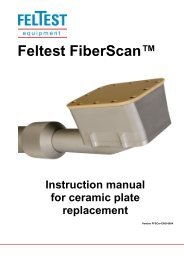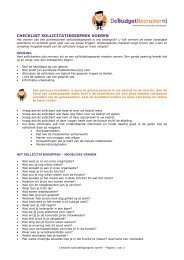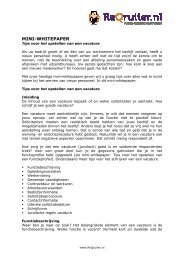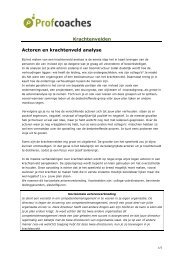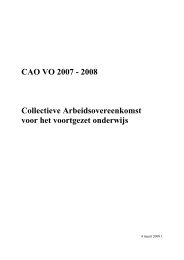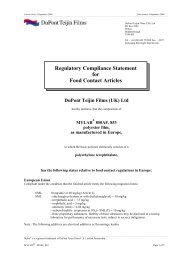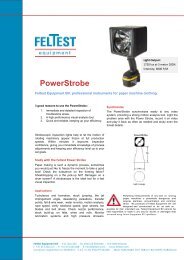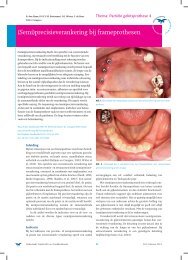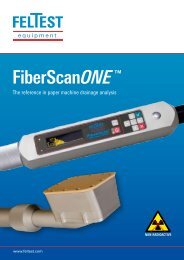Newborn screening in Europe Expert Opinion document
Newborn screening in Europe Expert Opinion document
Newborn screening in Europe Expert Opinion document
Create successful ePaper yourself
Turn your PDF publications into a flip-book with our unique Google optimized e-Paper software.
FINAL 28/08/2011been funded by the EU (ORPHANET, EUROCAT). 17 These stakeholders could be <strong>in</strong>volved<strong>in</strong> explor<strong>in</strong>g the potential for expand<strong>in</strong>g NBS programs <strong>in</strong> a responsible way.Neonatal <strong>screen<strong>in</strong>g</strong> vs genetic <strong>screen<strong>in</strong>g</strong>Depend<strong>in</strong>g on the def<strong>in</strong>itions used, neonatal <strong>screen<strong>in</strong>g</strong> can be seen as a form of genetic<strong>screen<strong>in</strong>g</strong>, as many of the conditions screened for are autosomal recessive <strong>in</strong>herited disorders.Sometimes a test is only considered “genetic” when “DNA-based test<strong>in</strong>g” is referred to,however, usually “any unambiguous genetic <strong>in</strong>formation” is <strong>in</strong>cluded <strong>in</strong> the def<strong>in</strong>ition of“genetic” test<strong>in</strong>g. 18 The latter view implies that most neonatal <strong>screen<strong>in</strong>g</strong> is genetic <strong>screen<strong>in</strong>g</strong>,except for <strong>screen<strong>in</strong>g</strong> for congenital hypothyroidism, which is usually not genetic, and<strong>screen<strong>in</strong>g</strong> for congenital deafness, which is often but not always genetic.Some authors dist<strong>in</strong>guish “genetic test<strong>in</strong>g” from “genetic <strong>screen<strong>in</strong>g</strong>”, where “test<strong>in</strong>g” mayrelate to requests <strong>in</strong> <strong>in</strong>dividual health care, for <strong>in</strong>stance diagnostic or prenatal. Differentdef<strong>in</strong>itions exist. We use a broad def<strong>in</strong>ition of genetic test<strong>in</strong>g, that <strong>in</strong>cludes population<strong>screen<strong>in</strong>g</strong>.Genetic <strong>screen<strong>in</strong>g</strong> may raise multiple concerns about eugenics, abortion, storage and futureuse of samples, population-based DNA banks, breach of privacy, labell<strong>in</strong>g, stigmatisation,discrim<strong>in</strong>ation, fatalism, and many more. 19 Many of these concerns are not necessarily<strong>in</strong>herent to neonatal <strong>screen<strong>in</strong>g</strong>, but as for other forms of <strong>screen<strong>in</strong>g</strong>, they depend on howdecisions are made with respect to <strong>in</strong>troduc<strong>in</strong>g <strong>screen<strong>in</strong>g</strong>, how <strong>screen<strong>in</strong>g</strong> services areorganised and what safeguards are <strong>in</strong> place. Genetic <strong>screen<strong>in</strong>g</strong> does br<strong>in</strong>g with it certa<strong>in</strong>aspects that are not common to other forms of <strong>screen<strong>in</strong>g</strong>, <strong>in</strong>clud<strong>in</strong>g the issue that genetic<strong>in</strong>formation may also have implications for other family members. For preconceptional andprenatal genetic <strong>screen<strong>in</strong>g</strong> the „<strong>in</strong>tervention‟ may not be a specific treatment, but rathernondirective counsell<strong>in</strong>g to better understand reproductive choices <strong>in</strong> light of the test results.Neonatal <strong>screen<strong>in</strong>g</strong> may lead to the identification of carriers, for <strong>in</strong>stance if HPLC is used for<strong>screen<strong>in</strong>g</strong> for sickle cell disease, or DNA analysis is performed <strong>in</strong> cystic fibrosis <strong>screen<strong>in</strong>g</strong>. Ifthe newborn is a carrier, at least one of the parents is a carrier, and the risk that the parents area carrier couple is <strong>in</strong>creased. It is thus relevant for the parents to be <strong>in</strong>formed of carrier statusas an <strong>in</strong>cidental f<strong>in</strong>d<strong>in</strong>g. There is grow<strong>in</strong>g <strong>in</strong>ternational consensus that any abnormal resultsassociated with cl<strong>in</strong>ical significant conditions, <strong>in</strong>clud<strong>in</strong>g the def<strong>in</strong>itive identification of carrierstatus, should also be reported. 20 However, not all countries agree with this position. InGermany for <strong>in</strong>stance the law protects the right not to know, and prohibits <strong>in</strong>form<strong>in</strong>g parents17 http://www.orpha.net/consor/cgi-b<strong>in</strong>/<strong>in</strong>dex.php; http://www.eurocat-network.eu/18P<strong>in</strong>to-Basto et al. Scope of def<strong>in</strong>itions of genetic test<strong>in</strong>g: evidence from a EuroGentest survey. J CommunityGenet (2010) 1:29–35 http://www.eurogentest.org/uploads/1273480884000/JCommGenet2010(1)29-35.pdf19 Andermann A, Blancquaert I, Dery V. A conceptual framework for genetic <strong>screen<strong>in</strong>g</strong> and policy-mak<strong>in</strong>g.Journal of Health Services Research & Policy 2010;15: 90-97.20 <strong>Europe</strong>an Society of Human Genetics. Genetic test<strong>in</strong>g <strong>in</strong> asymptomatic m<strong>in</strong>ors: Recommendations of the<strong>Europe</strong>an Society of Human Genetics. Eur J Hum Genet. 2009;17:720-1.Burton H, Moorthie S. Expanded newborn <strong>screen<strong>in</strong>g</strong>. A review of the evidence. Cambridge, PHG foundation,2010.Bombard Y, Miller FA, Hayeems RZ, Avard D, Knoppers BM, Cornel MC, Borry P. The expansion of newborn<strong>screen<strong>in</strong>g</strong>: is reproductive benefit an appropriate pursuit? Nat Rev Genet. 2009;10:666-7.Borry P, Nys H, Dierickx K. Carrier test<strong>in</strong>g <strong>in</strong> m<strong>in</strong>ors: conflict<strong>in</strong>g views. Nat Rev Genet. 2007 Nov;8(11):828.12




